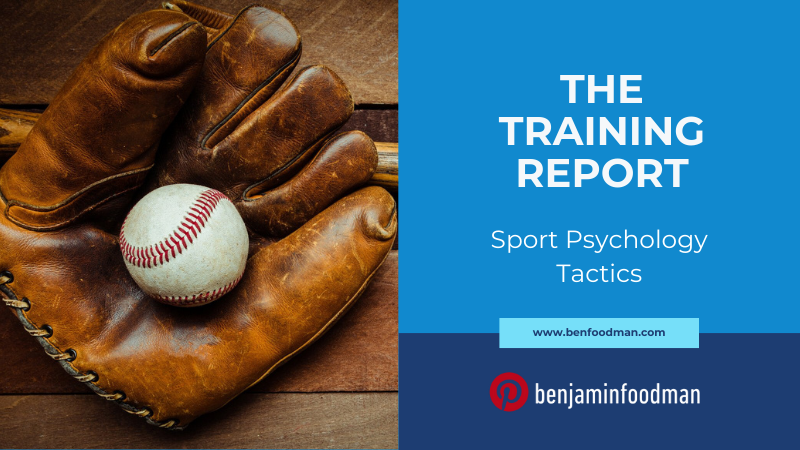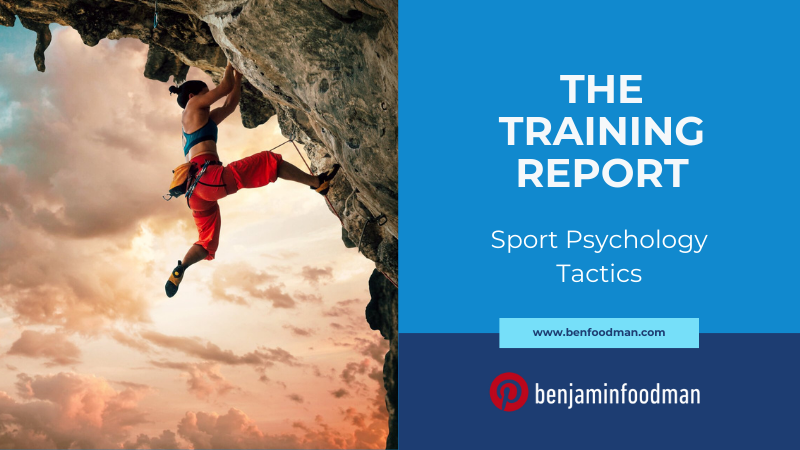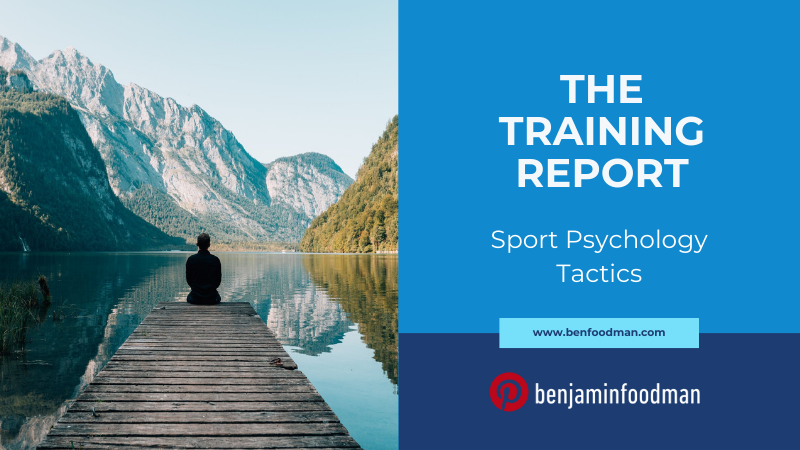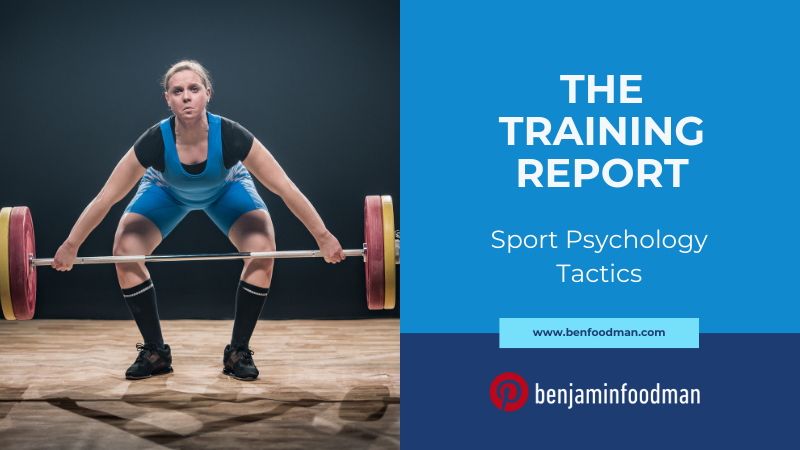Sport Psychology Tactics - Psychological Pre-Performance Routines Used By Olympic & Paralympic Athletes
About the Author
Ben Foodman is a licensed psychotherapist & performance specialist. He owns his private practice located in Charlotte North Carolina where he specializes in working with athletes to help them overcome mental blocks (the yips), PTSD, ADD / ADHD and achieve flow states through the techniques of Brainspotting & Neurofeedback. If you are interested in services, use the link here! Enjoy the article below!
Introduction: Olympians, Paralympians & Sport Psychology
The experience of being an Olympic & Paralympic athlete will mean different things to different people. However, one common feature that all of these athletes share is that they want to compete and win at the highest level. Their desire to dominate in their sport brings a type of intensity that is unique across the sporting environment. So in order to make sure that Olympians & Paralympians are able to accomplish their performance goals, these athletes recognize that they need to be just as committed to training their mind as their bodies. For this edition of the Training Report, we will discuss sport psychology tactics that Olympic & Paralympic athletes frequently use to enhance their psychological performance during training and sport competition. Before we go into specific skills that can be applied to this group of competitors, we need to first breakdown what sport psychology is and why these athletes need to train their minds.
Part I. Sport Psychology Tactics
Sport psychology is a field of study that explores psychological factors that affect sport performance, as well as the different strategies that athletes can use to overcome these mental hurdles. Some of the mental skills that Olympians and Paralympians would incorporate into their performance include imagery, autonomic nervous system regulation strategies, enhancing motivation, improving concentration & cognitive techniques for building confidence (Williams & Krane, 2015). But why would it be important for Olympians and Paralympians to practice these skills on a regular basis?
This population of athletes spend a great deal of time developing their bodies for their specific sport performance domain. For instance, many Olympic weightlifters will work with strength and conditioning specialists in order to increase muscle size, improve speed, and effectively periodize their training so that they are ‘peaking’ in time for competition. But since competing in sports is both a physical and mental experience, it would only be logical to also train the mental side of the their overall performance. With that being said, we need to examine the research that supports the performance enhancing benefits of mental skills training.
Part II. Internal Zone Of Optimal Functioning (IZOF)
Sport psychology based interventions are now being recognized as an instrumental part of achieving peak performance. In fact, commitment to mental skills training has become so widely accepted that the United States Olympic & Paralympic Committee has developed a registry of qualified professionals that provide mental performance consultation to all of the athletes they serve (Williams & Krane, 2015). One way these professionals help provide mental skills training is by trying to positively manipulate the Internal Zone of Optimal Functioning (IZOF). The IZOF refers to different sets of psychological characteristics that are either positively or negatively associated with peak performance. Using imagery during training and performance is an example of positively influencing the IZOF, because imagery can positively affect many of the IZOF characteristics such as being motivated, energetic, willing, etc. (Vealey & Forlenza, 2015). Another example of sport psychology based interventions that have shown to significantly enhance positive IZOF characteristics is regulation of the autonomic nervous system (Krane & Williams, 2015). The autonomic nervous system is composed of multiple branches that affect heart rate and release of specific hormones that can trigger either a relaxation or the fight or flight response.
These branches include the sympathetic and parasympathetic nervous systems which can be influenced by Olympians & Paralympians controlling their breathing through either specific deep exhales or shallow breaths. We’ll explore this in more detail later in this Training Report (Hanton, Mellalieu & Williams 2015). While these examples of sport psychology are typically thought of as ‘performance enhancing skills’, they are also transferable within the domain of mental health. Research has shown that athletes who have higher levels of anxiety and depression are also susceptible to increased risk for injury and poor performance outcomes, which makes utilizing mental skills training even more imperative. Many skills within the field of sport psychology are frequently used by mental health clinicians to help individuals manage these symptoms of emotional dysregulation and decrease psychological stress. Now that we have provided evidence to support the use of mental skills training, we want to explore the importance of developing a pre-performance routine that focuses on mental skills application (Williams & Scherzer, 2015).
Part III. Olympians, Paralympians & Pre-Performance Routines
A pre-performance routine is used by many athletes to help mentally prepare for performance. But why would it be critical to engage in this type of ‘psychological warm up’ before starting a sporting activity? As an elite level athlete, imagine if you were traveling from your home to your specific training facility. You exit your vehicle, enter into the gym, but instead of going to the locker room to change or physically warm up, you just begin exercising. Many of us recognize that this scenario is missing an important transition phase from a sedentary state to an active state. It would then stand to reason that your mind needs a similar transition period to consciously prepare for training and competition. A pre-performance routine accomplishes this, in that it helps synchronize the mind and body connection so that Olympians & Paralympians can more effectively produce their desired performance outcomes. Many sports have different types of pre-performance routines, but the two previously mentioned skills of imagery and autonomic nervous system regulation are regularly used by these athletes for good reason. Let’s explore what these skills are and how they should be used in a pre-performance routine (Bauman, 2012).
Part IV. Imagery & Peak Performance
Imagery is the process of creating and recreating an experience in your mind. When athletes engage in imagery routines, research has shown they are more likely to have successful outcomes compared to athletes that do not use imagery routines. There are several theories that support why this seems to be an effective intervention. The first one is Functional Equivalence theory, which describes how athletes that use imagery will simultaneously activate the same areas of their brain that are in use during athletic movements (Holmes & Collins, 2001; Jeannerod, 1994). Next, Bioinformational Theory (Lang, 1977, 1979) suggests that mental images are a collection of traits that are stored in areas of the brain associated with long-term memory. Therefore, Olympians and Paralympians using imagery will be ‘mentally prepared’ and physically activated in the way they need to be before performance begins.
When going through an imagery routine, Olympians and Paralympians will usually close their eyes, and visualize what they want to happen. Different sports will benefit from different perspectives but many athletes report that a first person perspective seems to be the ideal viewing point for this experience. In addition to visualizing what they want to see, Olympians and Paralympians also try to feel the kinesthetic sensations that accompany positive performance outcomes. Turning imagery into a polysensory/psychosomatic experience can enhance the vividness and quality of the imagery routine (Vealey & Forlenza 2015). While imagery is a great tactic, it is important that we also explore autonomic nervous system regulation and how this skill can is used to manage an Olympian and Paralympian’s nerves.
Part V. Peak Mental Performance & Deep Breathing
As previously mentioned, Olympians and Paralympians can consciously tap into their ideal IZOF by utilizing breathing techniques that influence the sympathetic and parasympathetic nervous system. The parasympathetic nervous system (PNS) is associated with being able to slow down heart rate while the sympathetic nervous system (SNS) dramatically speeds up heart rate. This is important because during high pressure situations, athletes can experience high SNS which unfortunately can translate into significant levels of stress, muscle tension, anxiety and other negative symptoms (Hanton, Mellalieu & Williams 2015; Porges, 2011). In order to minimize SNS activity, Olympians and Paralympians can utilize a type of deep breathing technique referred to as diaphragmatic ratio breathing. This is an intervention that can stimulate a relaxation response, eliminate common physiological stress reactions, and help the athlete more effectively navigate complex cognitive tasks during sporting events.
During deep breathing Olympians and Paralympians utilize diaphragmatic breathing techniques by taking in a long inhale and then follow up with an even longer exhale, forcefully pushing all of the air out from their lungs. These elite athletes usually follow a ratio count of 1:2, meaning that for every one second the athlete inhales, they exhale for two seconds (Hanton, Mellalieu & Williams 2015; Hayes, 2012). Olympic and Paralympic athletes usually practice this style of breathing in a setting that mimics competition environments. This will help them better prepare to accurately apply this skill during the chaos of competition. Finally, Olympic and Paralympic athletes most of the time factor in their competition start time, as this will also affect when they should implement the skill. The longer they can manage their heart rate, the more likely they are to have saved energy for their actual competition.
Part VI. Sport Psychology Training For Olympians & Paralympians
Now that we have explored in detail what imagery & deep breathing are, we need to discuss practical ways these skills can be used. First, athletes trying this for the first time should start by deciding whether they need to be more active in their parasympathetic or sympathetic nervous system in order to determine which type of breathing method will need to be employed. If athletes feel they need to spend more time reducing their performance anxiety, it will be more advantageous to start deep breathing anywhere from one to several hours before competition. As previously stated, the longer athletes can stay in a high PNS state, the longer it will take them to reach a high SNS state if they begin to experience increases in anxiety. Athletes should start with a 4 second inhale count and an 8 second exhale count continuously. This continuous process should take anywhere from ten to twenty minutes. However, if athletes need to increase their nerves and tap into their SNS then they should take fast shallow breaths with shorter exhales closer to the actual moment of competition (anywhere from five to ten minutes beforehand). Athletes can use a 2:1 inhale exhale count when trying to increase activation.
In regards to Imagery, it is recommended by professionals within the field of sport psychology to utilize imagery either immediately before or during the performance. For instance, Olympic and Paralympic athletes that utilize imagery before their performance close their eyes, and begin going through their specific imagery plan. As previously stated, this imagery experience should mimic what the individual wants to happen rather than what they don’t want to happen. If athletes should choose to use imagery during performance, they will need to make sure that they emphasize the somatic component of imagery and will need to have practiced this skill extensively during training (Jensen, 2017). Athletes can also create an imagery script that they can record and use as a guide to create the imagery experience. The following is an example of an imagery script: I am confident, focused, and more determined than my competition. Prior to my warm up, my muscles feel activated, and my body feels as if it’s in the best shape ever. I begin my warm up, and am surprised at how easy it is to execute the movements I normally do. I feel faster than I usually do. I know exactly what it looks like to get from Point A to Point B and will arrive at my destination exactly as I envision it. I step up to begin the competition and know that I am prepared.
Ultimately, Olympians & Paralympians are training and competing with the mindset to compete against high level competition, and in order to do that they need to perform with high-level precision focus. Oftentimes the difference between competitors is in inches or seconds, therefore elite level athletes that are looking for an edge in performance should strongly consider implementing evidence based sport psychology interventions into their training and competition routines. Based on the relevant sport psychology research, athletes that are using a pre-performance routine consisting of imagery and autonomic nervous system regulation will be in a better position to accomplish their desired performance outcomes. After reading this Training Report, my hope is that athletes and coaches will start implementing these tactics into their training and achieve the results of peak mental performance!
Note To Reader:
If you are an athlete reading this segment of the TRAINING REPORT, hopefully this content was helpful! I put the Training Report together because I felt like many of the discussions on issues such as the Yips/mental blocks, strength training & other subject matter on athlete performance concepts were really missing the mark on these ideas (e.g. how trauma is the direct cause of the Yips). If you are interested in learning more, make sure to subscribe below for when I put out new content on issues related to sport psychology & athlete performance! Also, if you are looking to work with a mental performance specialist, you are in the right place! USE THIS LINK to reach out to me to see if my services are the right fit for your goals!
ARE YOU ON THE LIST?
Make sure you’re signed up to Ben’s mailing list to receive news & updates on new strategies in sport psychology, upcoming workshops & products. Don’t wait, sign up now!























































































